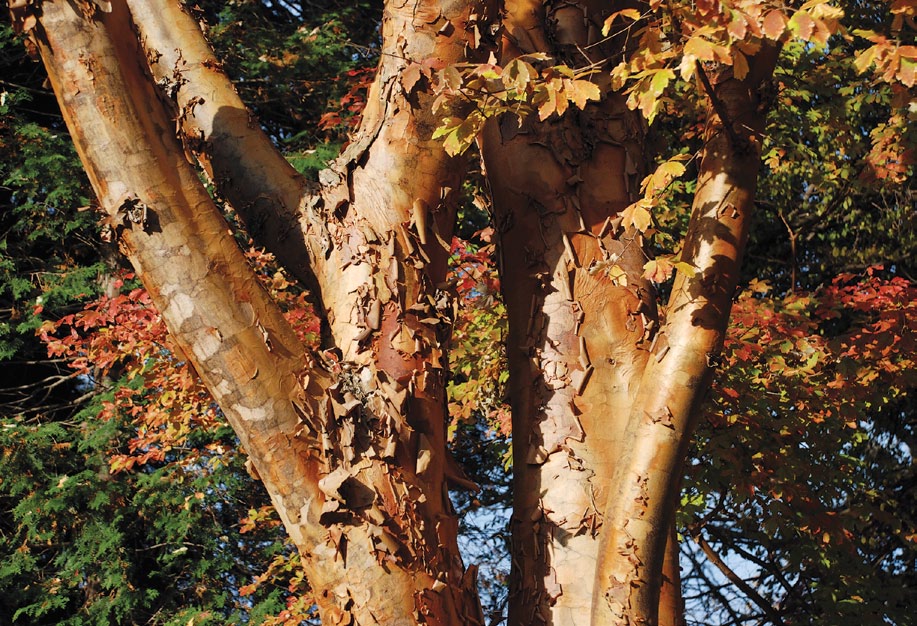During NACPEC expeditions plant species are targeted for collection for a range of reasons including environmental adaptabilities, conservation value, and ornamental features. Presented here are thirteen profiles of notable plants collected on these expeditions.
Paperbark maple is an iconic Chinese species with beautiful exfoliating cinnamon-colored bark that never fails to grab attention. It is frequently highlighted in public gardens and connoisseurs’ gardens throughout the temperate world. It was first introduced to the United States by E. H. Wilson through the Arnold Arboretum in 1907.
In addition to its stunning bark, this species is widely admired for its clean, fine-textured foliage, orange-red fall color, and relatively small stature, usually under 35 feet (10.7 meters) tall. It is believed that until recently, all or most paperbark maples in the United States derived from the genetically narrow 1907 Wilson introduction—it consisted of only two plants. Some contemporary seedlings lack vigor, a possible sign of inbreeding over the past century. The re-collection of paperbark maple to introduce greater genetic diversity has been a high priority from the very beginning of NACPEC planning.
Of the many hundreds of plants I have observed and collected in China, none were more exciting than finding a grove of wild paperbark maples on Wudang Mountain in Hubei in 1994. Wudang is the site of a famous Taoist temple, and the forests on its slopes have been relatively well protected. On September 21st, 1994, the Hubei expedition team was especially excited to find a scattering of paperbark maples in the understory of a rich, diverse forest at an elevation of 836 meters (2743 feet). It was one of the most biologically diverse habitats that any of us had ever experienced. Dubbed “horticulture heaven” by the collectors, we found many choice species including Stewartia sinensis, Cornus kousa, Cornus controversa, Ilex pernyi, and many others growing naturally on this mountainside.
The paperbark maples growing on Wudang Mountain were relatively small, growing on a west-facing slope in thin, rocky soil. Being in the understory, most were leggy and the foliage was high off the ground. With careful observation though, we spotted the winged samaras in the upper canopy. Using pole pruners, we were able to collect herbarium specimens and a small seed sample.

The following year, in April 1995, NACPEC team members Rick Lewandowski, Teicheng Cui, and Ned Garvey spotted an incredible specimen of paperbark maple in the Baxiam Forest Station in Shaanxi, less than 200 kilometers (124 miles) west of Wudang Mountain. They spotted the tree from afar; its leaves had not yet emerged, and they were struck by a distinct warm orange glow reflecting from the tree’s bark. The collectors wrote in their journal, “Holy Hannah! We encountered the biggest specimen we ever saw of Acer griseum. This was incredible… We can’t describe the impact of the bark color and the massive stem—the effect was overwhelming.” This tree measured 81.4 centimeters (32 inches) in diameter at 3 meters (9.8 feet) above the ground. It was estimated to be about 27 meters (88.6 feet) tall. Though no collections of living germplasm resulted, the herbarium specimens, descriptions, and photographic documentation of this individual tree have redefined our thinking about the potential of this species.
Paperbark maple is known to frequently produce empty samaras with no viable seeds. That was the case with the Hubei collections. After cutting open many samaras, we found a few (less than 5 percent) with seemingly viable seeds. Fortunately, there were also small seedlings growing under the trees, some of which were carefully dug bare-root, stripped of their senescing leaves, and packed in moist sphagnum moss. The seeds never germinated, but these dormant seedlings were brought home successfully and 13 are growing at NACPEC institutions. Though this lack of viability is frustrating to a propagator, the upside is that this species has little potential of becoming invasive.
I live on the grounds of the Morris Arboretum and two of the Wudang Mountain paperbark maples are growing in my garden. One is an especially fine specimen. It is a very vigorous individual and in its youth it grew more than 1 meter (3.3 feet) a year. Today it stands over 8 meters (26.2 feet) tall and has a diameter of 27 centimeters (10.6 inches) measured 30 centimeters (11.8 inches) from the ground, just below the first branch. Perhaps because of its strong growth, its bark is especially beautiful, with heavy exfoliation.
Citation: Meyer, P. W. 2010. Paperbark maple: Acer griseum. Arnoldia, 68(2): 48–50.
Morris Arboretum propagator Shelly Dillard took cuttings of this tree in 1998, 1999, 2000, and 2001 while the tree was still juvenile. None rooted successfully. In 2001, I rooted a low branch of the tree in my garden by layering, resulting in the only successful propagation of this individual. This layered plant has the same vigorous habit as its parent, and in July 2010 it had a 6.2 centimeter (2.4 inches) diameter measured 30 centimeters (11.8 inches) from the ground and stood about 3.5 meters (11.5 feet) tall. Four other individuals of this Hubei accession are growing at the Morris Arboretum and each year we watch them, hoping that one might produce some fertile seed for growing on and further evaluation.
Bibliography
Del Tredici, Peter. 2007. The Paperbark Maple—One Hundred Years Later. Arnoldia 65(2): 40.
Del Tredici et al. 1995. Plant Collecting on Wudang Shan. Arnoldia 55(1): 12–20.
Paul W. Meyer is the F. Otto Haas Director of the Morris Arboretum of the University of Pennsylvania in Philadelphia, Pennsylvania.
